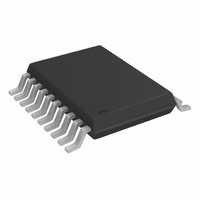AD5253BRU100 Analog Devices Inc, AD5253BRU100 Datasheet - Page 26

AD5253BRU100
Manufacturer Part Number
AD5253BRU100
Description
IC,Digital Potentiometer,TSSOP,20PIN,PLASTIC
Manufacturer
Analog Devices Inc
Datasheet
1.AD5254BRUZ100.pdf
(32 pages)
Specifications of AD5253BRU100
Taps
64
Resistance (ohms)
100K
Number Of Circuits
4
Temperature Coefficient
650 ppm/°C Typical
Memory Type
Non-Volatile
Interface
I²C, 2-Wire Serial
Voltage - Supply
2.7 V ~ 5.5 V, ±2.25 V ~ 2.75 V
Operating Temperature
-40°C ~ 85°C
Mounting Type
Surface Mount
Package / Case
20-TSSOP
Resistance In Ohms
100K
Lead Free Status / RoHS Status
Contains lead / RoHS non-compliant
AD5253/AD5254
APPLICATIONS INFORMATION
RGB LED BACKLIGHT CONTROLLER
FOR LCD PANELS
Because high power (>1 W) RGB LEDs offer superior color
quality compared with cold cathode florescent lamps (CCFLs)
as backlighting sources, it is likely that high-end LCD panels
will employ RGB LEDs as backlight in the near future. Unlike
conventional LEDs, high power LEDs have a forward voltage of
2 V to 4 V and consume more than 350 mA at maximum
brightness. The LED brightness is a linear function of the
conduction current, but not of the forward voltage. To increase
the brightness of a given color, multiple LEDs can be connected
in series, rather than in parallel, to achieve uniform brightness.
For example, three red LEDs configured in series require an
average of 6 V to 12 V headroom, but the circuit operation
requires current control. As a result, Figure 45 shows the
implementation of one high power RGB LED controller using a
AD5254, a boost regulator, an op amp, and power MOSFETs.
Rev. B | Page 26 of 32
The ADP1610 (U2 in Figure 45) is an adjustable boost regulator
with its output adjusted by the AD5254’s RDAC3. Such an
output should be set high enough for proper operation but low
enough to conserve power. The ADP1610’s 1.2 V band gap
reference is buffered to provide the reference level for the
voltage dividers set by the AD5254’s RDAC0 to RDAC2 and
Resistor R2 to Resistor R4. For example, by adjusting the
AD5254’s RDAC0, the desirable voltage appears across the
sense resistors, R
and power MOSFET N1 do whatever is necessary to regulate
the current of the loop. As a result, the current through the
sense resistor and the red LEDs is
R8 is needed to prevent oscillation.
In addition to the 256 levels of adjustable current/brightness,
users can also apply a PWM signal at U3’s SD pin to achieve
finer brightness resolution or better power efficiency.
I =
R
V
R
RR
R
R
. If U2’s output is set properly, op amp U3A
(8)












